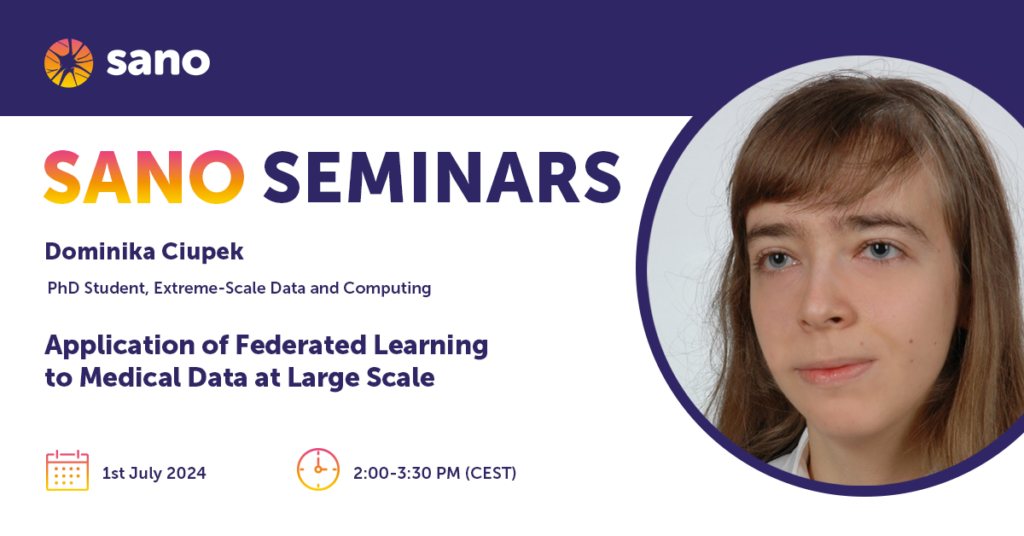139. Application of Federated Learning to Medical Data at Large Scale
Dominika Ciupek – PhD Student, Extreme-Scale Data and Computing, Sano Centre for Computational Medicine, Krakow, PL
Abstract:
Artificial intelligence is currently one of the fastest-growing fields in science. To achieve high accuracy, modern deep learning models require large and diverse datasets for training. Creating such datasets, especially with medical data, is challenging due to two main factors. 1) The sensitive nature of medical data requires thorough protection and removal of patient-identifying information. 2) Large and diverse datasets are unlikely to be available for free due to the significant effort and time required for their creation and management [1].
For this reason, exploring alternate ways of training neural networks is crucial. Federated learning [2] reverses the standard machine learning paradigm: instead of collecting datasets from various institutions on a single server, only the locally trained models’ parameters are transferred and used to generate the global model. The essential element of the federated learning framework is the aggregation method, which enables the calculation of the central model’s parameters. The quality of the global model on all institutions’ data largely relies on these techniques [1,3].
Numerous studies have been conducted on the application of federated learning in medical imaging, particularly for X-ray images [4]. However, as many articles show, these studies rely on simplistic aggregation algorithms, such as FedAvg [2] or FedProx [5], which may perform poorly with more heterogeneous data. Thus, it is crucial to comprehensively analyze the various existing algorithms, ranging from basic to specialized, for particular applications or data types.
The research aims to analyze the potential application of federated learning to MRI [6] and diffusion MRI data [7]. The results confirm the significance of utilizing federated learning and its advantages, particularly regarding data security and the generalization of deep learning models.
[1] Rieke, N., Hancox, J., Li, W., et al. (2020). The future of digital health with federated learning. Npj Digital Medicine, 3.
[2] McMahan, B., Moore, E., Ramage, D., et al. (2017). Communication-Efficient Learning of Deep Networks from Decentralized Data. Proceedings of the 20th International Conference on Artificial Intelligence and Statistics, 273-1282.
[3] Li, T., Sahu, A.K., Talwalkar, A., Smith, V. (2020). Federated learning: challenges, methods, and future directions. IEEE Signal Processing Magazine, 37(3), 50-60.
[4] Ciupek, D., Malawski, M., Pięciak, T. (2024). Federated Learning: A new frontier in the exploration of heterogeneous data in medical imaging. arXiv (available in July/August 2024).
[5] Li, T., Sahu, A.K., Zaheer, M., et al. (2020). Federated optimization in heterogeneous networks. Proceedings of Machine Learning and Systems, 429-450.
[6] Fiszer, J., Ciupek, D., Malawski, M., Pięciak, T. (2024). Federated image-to-image MRI translation from heterogeneous multiple-sites data. Abstract from 2024 ISMRM & SMRT Annual Meeting & Exhibition.
[7] Ciupek, D., Fiszer, J., Malawski, M., Pięciak, T. (2024). Grasping the Microstructural Parameters of the Brain in a Heterogeneous Multi-site Environment: a Federated Learning Approach. Abstract from NEURONUS Neuroscience Forum 2024.
About the author
Dominika Ciupek is a graduate of Biomedical Engineering at the Faculty of Electrical Engineering, Automatics, Computer Science and Biomedical Engineering at the AGH University of Krakow. In 2021, she defended her engineering thesis “Multicompartment models in diffusion-relaxometry magnetic resonance imaging” and in 2022, with distinction, her master’s thesis on the analysis of the variability of microstructural parameters along the white matter pathways across the lifespan. Currently, she is pursuing her PhD at Sano as part of the Extreme-scale Data and Computing team.


